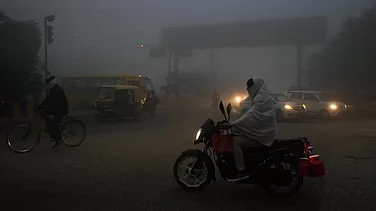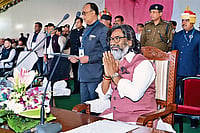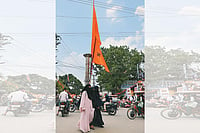What should a global city look like? The perceptions about the global city as prevalent among the upper-caste middle-class population of the metropolitans comprise skyscrapers, shopping malls, greenery and uncompromisingly safety. The image floated about ‘urban development’ in the post-liberalisation era was more of a clean, well-connected and secured abode uninterrupted by the outsiders than any of a society believing in equitable distributive justice.
Urban Sociologist D Asher Ghertner rightly finds out the driving force that upholds such images of uninterrupted cities. It is aesthetics. Rule by aesthetics means governing through the means of appearance, not through any rational or scientific measure. The view of what a world class city should be though is multi-dimensional, the point of agreement lies in keeping the ‘dirty’ unaesthetic ‘them’ outside. The ‘them’ can be security guards, domestic workers, laundryman or anybody and everybody who stays outside the ‘gates’ to ‘maintain’ the ‘gated’.
A hostage, a slap, an outsider
Five years ago, when the news of a domestic worker, namely Zohra Bibi, being allegedly taken hostage at a Noida Sector 78 gated community stormed the media for all the right reasons, a demographic transition followed. Upon receiving complaints from the Mahagun Moderne Society where Zohra was found in the basement, the police demolished the nearby slums saying they were illegally ‘occupying’ the government land.
However, this illegal occupation came to the notice of the administration only when Zohra’s neighbours and family barged into the Mahaguna society and razed down the furniture of the apartment where she allegedly went to bring her two months’ salary but never came back. What the entry of those ‘violent dirty others’ within the peaceful secured compound signified was the breaking of the ‘gate’ and hence of the prevalent ‘aesthetics’.
The entry of these 'outsiders' within the ‘gated’ premises is always monitored. The feudal relationship that reproduces the master-slave binary was certainly collapsed by that storming troop. The consequence was a foregone conclusion. While removing the clusters of slums that offered shelters to Zohras, one proud bureaucrat roared, “We have demolished 60 structures. Encroachment on government land cannot be allowed.”
It has been five years since the Zohra incident. However, expectedly situation has not changed a bit.
A few days back a report came from another Noida housing society where a woman professor was found slapping a security guard who allegedly was late in opening the ‘gate’ of the society. As the Radio Frequency Identification (RIFD) mechanism of the women’s car did not work, the security guard was supposed to rush to open the ‘gate’.
Whatever it may be, the insiders cannot wait at the outside of the ‘gate’ that they have erected to keep the others at bay! The professor got out of the car and abused and slapped the guard. She was taken by police on a complaint, only to be released by the afternoon for committing a non-cognisable offence.
These two reported incidents speak of the exploitation of the working people regularly experienced in their gated workspace.
Segregation: an othering reality
Redseer, one of the major management consulting firms in India, in its recent reports showed that gated communities are emerging as the most important consumption areas in Indian urban scenario. The consumption across gated communities is poised to more than double to $500 billion by 2026 with a significant $20,000 spend per household. This indicates how more and more urban middle class are preferring gated, secured and green residencies over any other possibility of living.
On the other hand, several scholars like Marxist Philosopher Zizek have projected a ‘Planet of Slums’ by 2050 where the number of people currently staying in squatters will be tripled.
Within this contradictory development of ‘Planet of Slums’ and the heaven of the gated communities lie a blurred line of dependency. The foundation of gated community always accompanies the constitution of nearby slums. The security guards, drivers, laundrymen, gardeners, domestic workers and the gig workers, precisely, the virulent outsiders stay there. People from mostly marginalised communities —Dalits, Adivasis, Muslims— occupy these spaces. So, it becomes further easy for the gated residents to demonise them. In the instance of Zohra, it was reported how the people who went on a rampage to find the woman were termed as ‘Bangladeshi immigrants’ due to their Bengali Muslim identity.
BR Ambedkar though called the villages ‘den of inequity’ and asked the Dalits to move to the cities, urbanity hardly had anything dignified in its coterie for them. A study conducted by Pranav Sidhwani, published in Economic and Political Weekly in 2015, showed the most populous 10 cities of India are the most residentially segregated zones. In the receiving end of the segregation always lie Dalits, Muslims and Adivasis. They not only live as the outliers, they hardly have access to the basic infrastructures like water, sewage and for that matter electricity. And interestingly most of these slums are located near the phallic structures of the gated communities.
A haunting anxiety
However, it is not to say that Dalits and Adivasis came from their villages and occupied the space. Most of the time, it is the urbanity that expanded and gradually gobbled up the village spaces. In case of New Okhla Industrial Development Authority, popularly known as Noida, several villages had been encroached upon. Losing the agricultural lands, the village people certainly found them surrounded by humongous structures. In the wake of such transition, the insider of the villages became the perennial outsiders — the drivers to mop their cars or the domestic workers to ‘maintain’ the aesthetic of the place.
This proximity of slums with the gated community is what makes the posh upper-caste citizens anxious. This anxiety is reflected through captivity, slapping, termination of jobs, holding of salaries for months and several other means. The presence of those whose place they knowingly occupied continuously haunts them. And when the gates are broken, all hells break loose. The inevitability of the labour of the others does not gel in with the dispensability of the bodies. In this way Zohras become the norm and when any subversion happens, it is responded with demolition of illegal encroachments.
Zohras are not alone, the casualties of aesthetic development are stretching its hands far beyond the marginalised. It is a not a distant reality when the bulldozer would be norm for a dissenting storm.



























